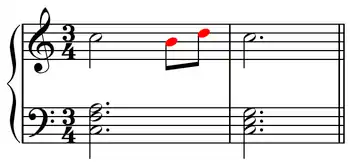Changing tones
In music, changing tones (also called double neighboring tones and neighbor group) consists of two consecutive non-chord tones.[1][2] The first moves in one direction by a step from a chord tone, then skips by a third in the opposite direction to another non-chord tone, and then finally resolves back to the original chord tone. Changing tones appear to resemble two consecutive neighbor tones; an upper neighbor and a lower neighbor with the chord tone missing from the middle. The changing tone functions as a way to decorate, or embellish, a chord tone and are also used to provide rhythmic interest between common tones. In rare instances, changing tones can be heard as musical cryptograms, such as the cruciform melody.

Changing tones
References
- Lobe, Johann Christian (1891). Catechism of Composition: By J. C. Lobe. G. Schirmer. pp. 63–65.
- Franceschina, John Charles (2015). Music Theory Through Musical Theatre: Putting it Together. Oxford University Press. pp. 126–127. ISBN 978-0-19-999955-2.
Wikimedia Commons has media related to Changing tones.
This article is issued from Wikipedia. The text is licensed under Creative Commons - Attribution - Sharealike. Additional terms may apply for the media files.
